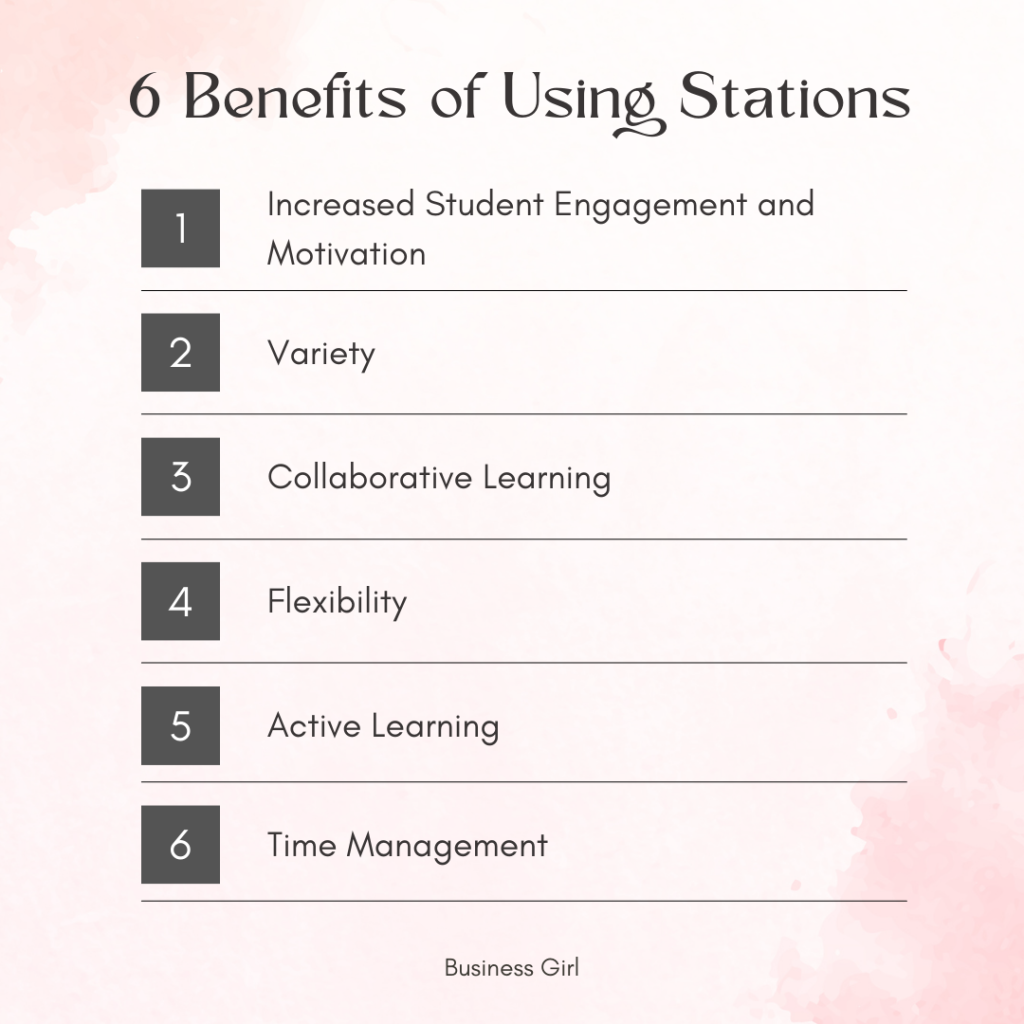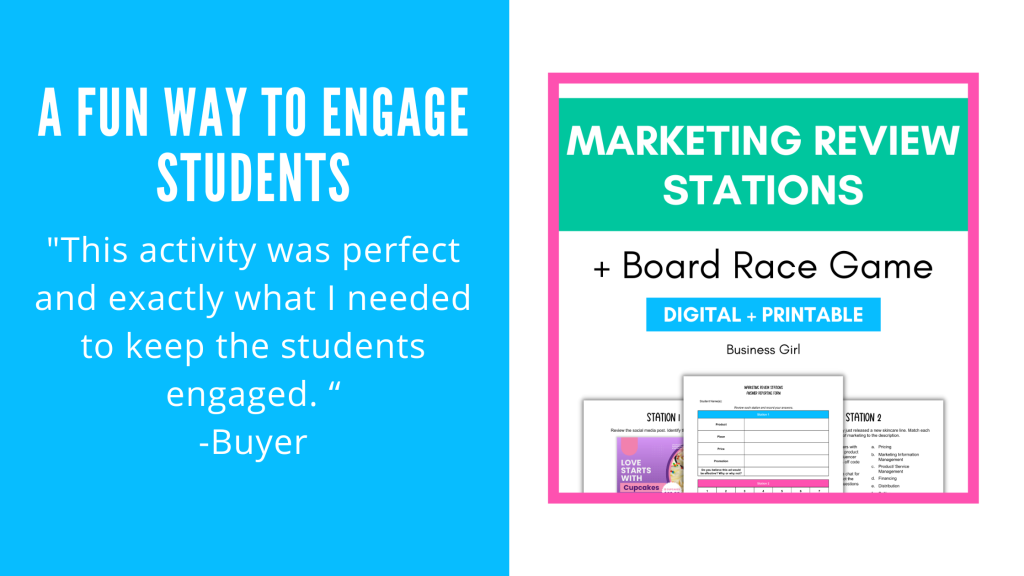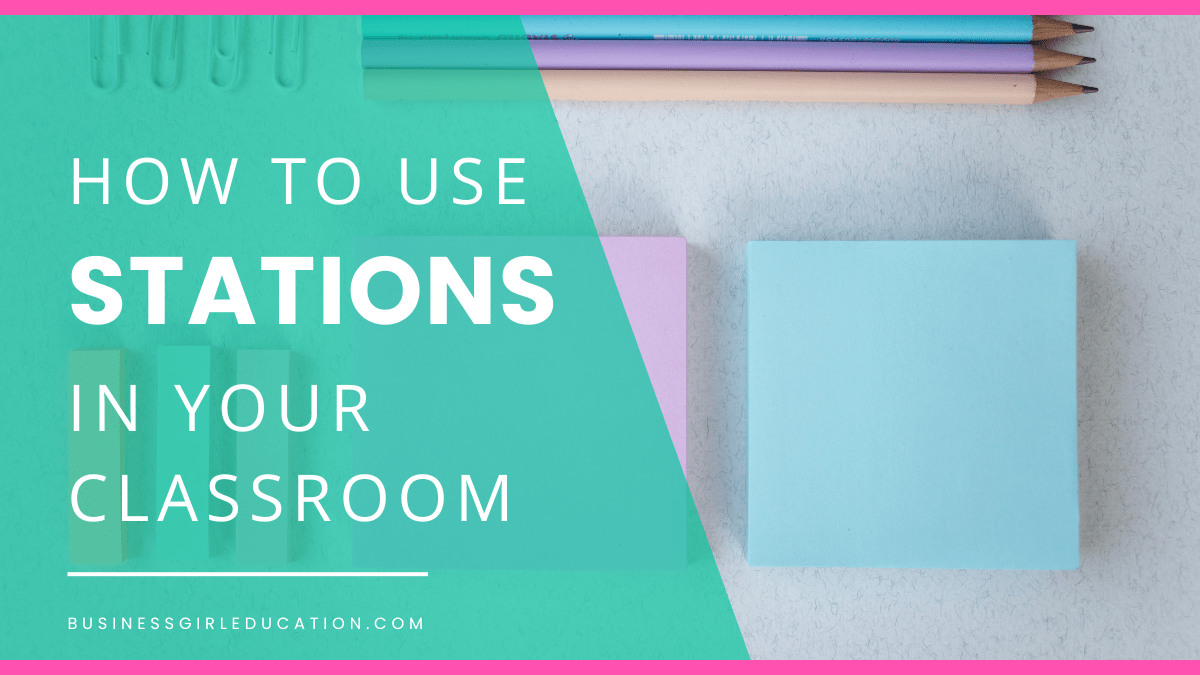Are you looking for a way to mix things up in your classroom? Something that would allow you to get students up and out of their seats while maintaining course rigor?
Stations are an interactive teaching strategy that can transform a boring class into a collaborative learning experience. Stations can help engage your students and add variety to your lessons.
Stations provide a multifaceted approach to education, enhancing student engagement and promoting active learning while fostering collaboration and critical thinking.
Benefits
Using stations in the classroom can offer a variety of benefits for both students and teachers.

Here are some of the key benefits of using stations in your classroom:
1. Increased Student Engagement and Motivation: Stations allow for a more active and hands-on approach to learning, which can help to increase student engagement and interest in the lesson. With stations, students take ownership of their learning.
2. Variety: Stations can break up the monotony of a class period by allowing students to get out of their seats and move around the classroom. By rotating through different stations, students experience different learning formats, materials, and activities, keeping them motivated and interested in the subject matter.
3. Collaborative Learning: Working in small groups or pairs at different stations fosters teamwork, cooperation, and effective communication skills, which are crucial in the business world.
4. Flexibility: Stations can be adapted to suit different topics and learning objectives, making them a versatile teaching tool. Stations can incorporate a variety of materials to meet the needs of your students.
5. Active Learning: Stations promote active learning, which has been shown to be more effective for retaining information than passive learning. Students are actively involved in the activities, discussions, and collaborative tasks, which enhances their understanding and retention of business concepts.
6. Time Management: Stations can help teachers to manage class time more effectively, allowing students to work independently while you provide support and guidance as needed.
Using stations in the classroom can help to create a more dynamic and engaging learning experience while also providing opportunities for students to develop important skills and knowledge. Stations can help prepare students for the real-world challenges of the business world.
Want to explore a done-for-you set of stations? Try out the Marketing Review Stations.

Tips for Using Stations

1. Make sure you have enough stations for the number of students in the class.
When utilizing stations or other movement-based activities, it’s important to have enough stations for the number of students in your class. Not having enough stations will lead to a bottleneck and off-task students waiting around.
I recommend ~10 stations for 30 students. If you don’t have 10 stations, you can make 2 or 3 copies of the stations and assign students to a particular area. For example, if you have 5 stations, print 2 copies and assign half the class to the right side of the classroom and half the class to the left side of the classroom.
2. Determine the best structure prior to implementation.
How will your stations operate? Will students move freely from station to station? Will you set a timer and tell students to rotate when the timer goes off?
In general, I prefer to allow students to move from station to station as they finish each one. Setting a timer requires a little more discipline, and I prefer to use stations that require a similar amount of time to complete.
Each model has its place, and it’s important to select the format that best suits the designed stations.
3. Assign partners or small groups.
Stations are best completed with a partner or small group. Stations naturally lend themselves to a collaborative work environment. Assigning students a designated group to move around the room with can help keep them on task and build community.
4. Monitor students by moving around and providing feedback.
When students move around the room, they have the opportunity to interact with other students. In this environment, some students will need more verbal cues to stay on task.
Rotating around the room also allows you to provide individual feedback to students. Providing academic feedback helps students to master concepts and make corrections in the moment rather than at the end of the lesson.
5. Provide clear instructions to minimize confusion.
When using stations, it’s important that the stations are self-explanatory. For stations to run smoothly, make sure your instructions are simple and easy to understand.
6. Offer digital options to accommodate various student needs.
I recommend creating a digital version that can be used when needed. This accommodation can be used for a variety of reasons and be a helpful tool to have in your back pocket.
Stations Ideas

Are the wheels spinning on implementing stations into your own classroom?
Building stations can be a lot of fun. You can use a variety of tasks or tasks that all have a similar concept. I particularly like to use stations as a review for a unit.
Here are a few ideas to get you started:
- Sample business documents with questions
- What would you do or what would you recommend scenarios
- Rank content by importance
- List the content in order
- Matching questions
- Multiple choice questions
- True and false questions
- Puzzles or brain teasers
- Math problems
- Read an article or excerpt and answer questions
- Infographics with questions
Conclusion
Stations can be an effective strategy to add to your teaching toolkit. With a variety of applications, stations allow students to interact with the content, build communication skills, and take ownership of their learning.
With stations, your students can apply their knowledge, think critically, and collaborate effectively. By fostering a cooperative learning environment, stations equip students with vital skills such as teamwork, communication, and problem-solving, preparing them for future success in the business world.
>>For more ways you can get your students moving click here<<

